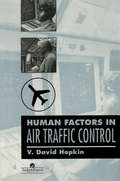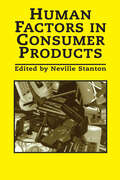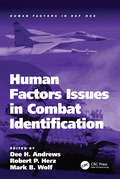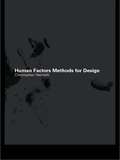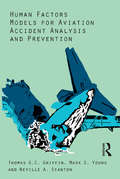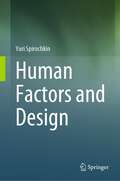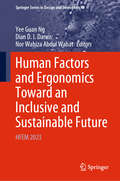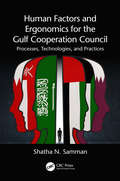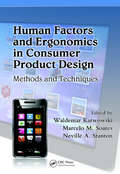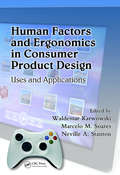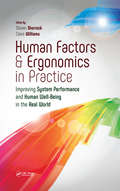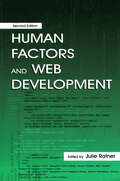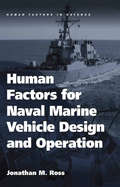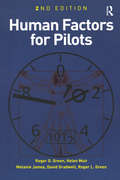- Table View
- List View
Human Factors Challenges in Emergency Management: Enhancing Individual and Team Performance in Fire and Emergency Services
by Christine OwenThis book provides an overview of state-of-the-art research that has been conducted within Australia, funded by the Bushfire Cooperative Research Centre. The chapters source and contextualize their own research practice within the context of the international research literature. Therefore, while the research has occurred within Australia it will be of particular interest to scholars, students and practitioners in a number of other countries, particularly within the United States of America and in Europe. The fire and emergency services is a particularly large industry - in Australia alone it employs 250,000 personnel - yet there is very little by way of published human factors books addressing this sector directly. Emergency events frequently involve problems for which there may be unanticipated consequences and highly interdependent consequential effects. In short, emergency events are not necessarily as containable as may be work in other domains. As Karl Weick once commented, emergency events do not 'play by the rules'. This means that these research chapters tell us something about a potential future world of work that is highly dynamic, interdependent and for which improvisation and critical thinking and problem-solving are necessary pre-requisites. The discussions about individual and team performance will also be pertinent to others working in similar high-reliability, high-consequence domains. The chapters connect into an integrated body of work about individual and group performance and their limitations.
Human Factors Engineering and Ergonomics: A Systems Approach
by Stephen J. GuastelloThis textbook comprehensively covers the basic principles and most recent advances regarding visual displays, auditory and tactile displays and controls; psychophysics; cognitive processes; human-computer interaction, artificial intelligence and artificial life; stress and human performance; occupational accidents and prevention; human group dynamics and complex systems; and anthropometry, workspace and environmental design. The systems perspective emphasizes nonlinear dynamics for system performance changes and emergent behaviours of complex person-machine systems.This book- • Surveys principles of conventional and computer-based machine interaction. • Assesses the relative effectiveness of accident analysis and prevention strategies. • Highlights nonlinear dynamics for system performance changes. • Examines artificial intelligence and complex systems. • Investigates sources of cognitive workload and fatigue. The textbook will be a valuable resource for advanced undergraduates and graduate students in diverse fields including ergonomics, human factors, cognitive science, computer science, operations management, and psychology. The textbook brings together core principles of person-machine interaction, accident analysis and prevention strategies, risk analysis and resilience, artificial intelligence, group dynamics, and nonlinear dynamics for an enhanced understanding of complex person-machine systems.
Human Factors In Air Traffic Control
by V. D. HopkinThis text discusses the skills and abilities that air-traffic controllers need. Its approach is international as air-traffic control practices throughout the world have to be mutually compatible and agreed.
Human Factors In Consumer Products
by Neville StantonThe design of consumer products has a central role in its potential for contributing to a healthier living and working space. However, too often consumers are only aware of the designers' role when bad practice manifestly exacerbates the easy application of basic functionality. This important book places human factors perspective firmly at the centre of good practice in consumer product design, encouraging rigorous human factors evaluation and methodology as an essential component of the design process.The book's central theme is to introduce human factors techniques to consumer product design and the efficacy of the approach is illustrated with several case studies from a diverse variety of products. Products addressed range from scissors to strimers, from pens to power tools, from kettles to cookers, from radio-cassettes to rucksacks, adn from razors to VCRs. Techniques brought to bear on the devices include: checklists, hierarchical task analysis, observations, interviews, error prediction, questionnaires, guidelines, focus groups, simulations and user trials. Key Features: * Foreword by Sean Blair of the Design Council* Valuable resource for professionals, academics and students in both human factors engineering and design* Fosters an approach which integrates the skills of both professions in a successful approach to consumer product design* Includes plenty of examples throughout the book
Human Factors Issues in Combat Identification (Human Factors in Defence)
by Dee H. Andrews Robert P. Herz Mark B. WolfThis edited book presents an array of approaches on how human factors theory and research addresses the challenges associated with combat identification. Special emphasis is placed on reducing human error that leads to fratricide, which is the unintentional death or injury of friendly personnel by friendly weapons during an enemy engagement. Although fratricide has been a concern since humans first engaged in combat operations, it gained prominence during the Persian Gulf War. To reduce fratricide, advances in technological approaches to enhance combat identification (e.g., Blue Force Tracker) should be coupled with the application of human factors principles to reduce human error. The book brings together a diverse group of authors from academic and military researchers to government contractors and commercial developers to provide a single volume with broad appeal. Human Factors Issues in Combat Identification is intended for the larger human factors community within academia, the military and other organizations that work with the military such as government contractors and commercial developers as well as others interested in combat identification issues including military personnel and policy makers.
Human Factors Methods and Accident Analysis: Practical Guidance and Case Study Applications
by Daniel P. Jenkins Neville A. Stanton Guy H. Walker Paul M. Salmon Michael Lenné Laura RaffertyThis book provides an overview of, and practical guidance on, the range of human factors (HF) methods that can be used for the purposes of accident analysis and investigation in complex sociotechnical systems. Human Factors Methods and Accident Analysis begins with an overview of different accident causation models and an introduction to the concepts of accident analysis and investigation. It then presents a discussion focussing on the importance of, and difficulties associated with, collecting appropriate data for accident analysis purposes. Following this, a range of HF-based accident analysis methods are described, as well as step-by-step guidance on how to apply them. To demonstrate how the different methods are applied, and what the outputs are, the book presents a series of case study applications across a range of safety critical domains. It concludes with a chapter focussing on the data challenges faced when collecting, coding and analysing accident data, along with future directions in the area. Human Factors Methods and Accident Analysis is the first book to offer a practical guide for investigators, practitioners and researchers wishing to apply accident analysis methods. It is also unique in presenting a series of novel applications of accident analysis methods, including HF methods not previously used for these purposes (e.g. EAST, critical path analysis), as well as applications of methods in new domains.
Human Factors Methods and Sports Science: A Practical Guide
by Paul Salmon Neville Anthony Stanton Adam Gibbon Daniel Jenkins Guy H. WalkerDuring the course of any sporting event, critical cognitive and physical tasks are performed within a dynamic, complex, collaborative system comprising multiple humans and artifacts, under pressurized, complex, and rapidly changing conditions. Highly skilled, well-trained individuals walk a fine line between task success and failure, with only slig
Human Factors Methods for Design: Making Systems Human-Centered
by Christopher P. NemethThere is no shortage of available human factors information, but until now there was no single guide on how to use this information. Human Factors Methods for Design: Making Systems Human-Centered is an in-depth field guide to solving human factors challenges in the development process. It provides design and human factors professionals, sys
Human Factors Methods: A Practical Guide for Engineering and Design
by Daniel P. Jenkins Neville A. Stanton Guy H. Walker Paul M. Salmon Laura A. Rafferty Chris BaberThis second edition of Human Factors Methods: A Practical Guide for Engineering and Design now presents 107 design and evaluation methods as well as numerous refinements to those that featured in the original. The book has been carefully designed to act as an ergonomics methods manual, aiding both students and practitioners. The eleven sections represent the different categories of ergonomics methods and techniques that can be used in the evaluation and design process. Offering a 'how-to' text on a substantial range of ergonomics methods that can be used in the design and evaluation of products and systems, it is a comprehensive point of reference for all these methods. An overview of the methods is presented in chapter one, with a methods matrix showing which can be used in conjunction. The following chapters detail the methods showing how to apply them in practice. Flowcharts, procedures and examples cover the requirements of a diverse audience and varied applications of the methods. The final chapter, a new addition, illustrates the EAST method, which integrates several well-known methods into a teamwork analysis approach.
Human Factors Models for Aviation Accident Analysis and Prevention
by Thomas G.C. Griffin Mark S. Young Neville A. StantonThe investigation and modelling of aviation accident causation is dominated by linear models. Aviation is, however, a complex system and as such suffers from being artificially manipulated into non-complex models and methods. This book addresses this issue by developing a new approach to investigating aviation accident causation through information networks. These networks centralise communication and the flow of information as key indicators of a system’s health and risk. This holistic approach focuses on the system environment, the activity that takes place within it, the strategies used to conduct this activity, the way in which the constituent parts of the system (both human and non-human) interact and the behaviour required. Each stage of this book identifies and expands upon the potential of the information network approach, maintaining firm focus on the overall health of a system. The book’s new model offers many potential developments and some key areas are studied in this research. Through the centralisation of barriers and information nodes the method can be applied to almost any situation. The application of Bayesian mathematics to historical data populations provides scope for studying error migration and barrier manipulation. The book also provides application of these predictions to a flight simulator study for the purposes of validation. Beyond this it also discusses the applicability of the approach to industry. Through working with a legacy airline the methods discussed are used as the basis for a new and prospective safety management system.
Human Factors and Behavioural Safety
by Jeremy StranksAccidents and cases of occupational ill-health are commonly associated with aspects of human behaviour and the potential for human error. Human Factors and Behavioural Safety is not written for psychologists, but instead gives health and safety professionals and students a broad overview of human factors and those aspects of human behaviour which have a direct effect on health and safety performance within organisations.Particular attention is paid to:* the role of the organisation in promoting safe behaviour* the sensory and perceptual processes of people* behavioural factors, such as attitude, motivation and personality* the process of attitude change* theories of personal risk taking and accident * the importance of good communication, change management and stress management
Human Factors and Design
by Yuri SpirochkinThis book describes various manifestations of human factors when interacting with potentially dangerous technical systems: airplanes, launch vehicles and spaceships, nuclear power plants, energy-saturated ground vehicles and infrastructure facilities. The idea of the book arose from the desire to find a common ground between industries that are important for safety. Their similarity lies, in addition to the technological advancement of products and solutions, in equally high safety requirements, in particular taking into account the influence of human factor. Thus, it is of relevance to analyze an impact of human factor in the context of safety. The matter is rather complex: on the one hand humans manage technical systems, on the other hand human errors, negligence or evil intentions can turn the system into a threat with disastrous consequences. However, human interaction with any technical system begins earlier – in the design stage. In this stage, designer, being creator of the system, must ensure a safe operation and take into consideration possible risks, including those caused by human factors itself. The book is interdisciplinary in nature and intended mainly for designers of technical systems, aiming to assist the specialists in understanding the issues of human participation in life cycle of these systems. The examples given are intended to benefit from experiences of not one, but a number of industries.
Human Factors and Ergonomics Toward an Inclusive and Sustainable Future: HFEM 2023 (Springer Series in Design and Innovation #46)
by Yee Guan Ng Dian D. I. Daruis Nor Wahiza Abdul WahatThis book gathers the refereed proceedings of the 5th HFEM Biennial Conference on Human Factors and Ergonomics, organized by the Human Factors and Ergonomics Society Malaysia, held in Langkawi, Malaysia on August 13–18, 2023. Under the theme "Accelerating Human Factors and Ergonomics Toward an Inclusive and Sustainable Future", it highlights the latest theories and models, as well as cutting-edge technologies and applications on human factors and ergonomics. By combining findings from a range of disciplines including engineering, design, robotics, health care, management, computer science, human biology, and behavioral science, it offers an excellent source of innovative ideas to stimulate future discussions and developments aimed at applying knowledge and techniques to optimize system performance, while at the same time promoting the health, safety, and well-being of individuals. It includes papers from researchers and practitioners, scientists and physicians, institutional leaders, managers, and policy makers that contribute to constructing the human factors and ergonomics approach across a variety of methodologies, domains, and productive sectors.
Human Factors and Ergonomics for the Gulf Cooperation Council: Processes, Technologies, and Practices
by Shatha N. SammanHuman Factors and Ergonomics (HFE) is introduced to students, academics, researchers, practitioners, policy makers, and others in the Gulf Cooperation Council (GCC). A holistic approach is taken to emphasize the breadth and depth of HFE by providing both theory and applications in the field. Providing HFE perspectives from expert academics from multidisciplinary and culturally diverse backgrounds, it contains case studies written by industry professionals highlighting their work from Bahrain, Kuwait, Oman, Saudi Arabia, and United Arab Emirates. Features The first HFE book for the GCC region with case studies showcasing the economics of ergonomics Presents easy to read chapters covering principles, methodologies, applications, future trends, and key terms Encompasses both the theory and application of HFE fields discussing processes, technologies, and practices Written for readers with no prior background of HFE
Human Factors and Ergonomics in Consumer Product Design: Methods and Techniques (Handbook of Human Factors in Consumer Product Design)
by Waldemar Karwowski Marcelo M. Soares Neville A. StantonEvery day we interact with thousands of consumer products. We not only expect them to perform their functions safely, reliably, and efficiently, but also to do it so seamlessly that we don't even think about it. However, with the many factors involved in consumer product design, from the application of human factors and ergonomics principles to red
Human Factors and Ergonomics in Consumer Product Design: Uses and Applications
by Waldemar Karwowski Marcelo M. Soares Neville A. StantonEvery day we interact with thousands of consumer products. We not only expect them to perform their functions safely, reliably, and efficiently, but also to do it so seamlessly that we don't even think about it. However, with the many factors involved in consumer product design, from the application of human factors and ergonomics principles to red
Human Factors and Ergonomics in Practice: Improving System Performance and Human Well-Being in the Real World
by Steven Shorrock Claire WilliamsThis edited book concerns the real practice of human factors and ergonomics (HF/E), conveying the perspectives and experiences of practitioners and other stakeholders in a variety of industrial sectors, organisational settings and working contexts. The book blends literature on the nature of practice with diverse and eclectic reflections from experience in a range of contexts, from healthcare to agriculture. It explores what helps and what hinders the achievement of the core goals of HF/E: improved system performance and human wellbeing. The book should be of interest to current HF/E practitioners, future HF/E practitioners, allied practitioners, HF/E advocates and ambassadors, researchers, policy makers and regulators, and clients of HF/E services and products.
Human Factors and Ergonomics in Sport: Applications and Future Directions
by Paul M. Salmon, Scott McLean, Clare Dallat, Neil Mansfield, Colin Solomon and Adam HulmeSport is an integral part of society, playing a key role in human health and well-being, and cultural, political and economic development. As sport is becoming more complex, competitive, diverse, and increasingly reliant on technology, HFE theories, methods, and principles are progressively being applied to help understand and optimize sports systems. Human Factors and Ergonomics in Sport: Applications and Future Directions showcases the latest in sports HFE research and practice. Including contributions from both HFE and sports science researchers, it provides a collection of state-of-the-art studies, reviews and commentaries covering a diverse set of sports and sporting issues. "This book is an excellent resource for all academics and students in general. It provides updated theoretical foundations and applications that conceive a world where everything is connected and embedded in technology that allows us to capture, process and visualise actions and interactions, also at transdisciplinary levels." Professor Jaime Sampaio, Head of the Research Center in Sports Sciences, Health and Human Development (CIDESD), University of Trás-os-Montes e Alto Douro, Portugal "With the changing nature of work comes an ever-greater focus on leisure. Sport is a major dimension of this crucial form of human activity. Now comes Salmon and his colleagues who have assembled a panoply of world leaders who each provide their own individual perspectives on this intriguing world. Their emphasis on the human factors and ergonomics of these activities brings us new and exciting insights. A great read for the specialist and generalist alike." Professor Peter Hancock, Pegasus Professor, Provost Distinguished Research Professor and Trustee Chair, University of Central Florida, USA. "Finally, the complexity of sports and health is being considered in full. This book challenges contemporary thinking toward the prevention of injuries in sports, and provides tangible solutions to help our field into a new decade." Professor Evert Verhagen, Amsterdam Collaboration on Health and Safety in Sports & Department of Public and Occupational Health, VU University Medical Center
Human Factors and Ergonomics of Prehospital Emergency Care
by Joseph R. Keebler Elizabeth H. Lazzara Paul MisasiThis book provides an introduction to the field of human factors for individuals who are involved in the delivery and/or improvement of prehospital emergency care and describes opportunities to advance the practical application of human factors research in this critical domain. Relevant theories of human performance, including systems engineering principles, teamwork, training, and decision making are reviewed in light of the needs of current day prehospital emergency care. The primary focus is to expand awareness human factors and outlay the potential for novel and more effective solutions to the issues facing prehospital care and its practitioners.
Human Factors and Safety Culture: How Leaders Can Influence Behaviours for Good
by Eduardo Blanco-MunozThis title explores human behaviour in the context of workplace safety and risk management. Focused on understanding how people detect, interpret and respond to danger and how leaders can put safety at the heart of their organizations’ culture, it draws on the latest insights from disciplines such as cognitive science, neuroscience, psychology, and sociology. Integrating traditional and emerging perspectives in the field of Occupational Health and Safety, this book delivers both a vision and the tools to elevate safety as a core organizational value able to motivate and anchor safe behaviours and reinforce safety‑oriented leadership.Written to include practical frameworks and clear examples, it addresses the cognitive processes, including perception, attention, and memory, that influence individuals’ judgement and decision‑making at work as well as spontaneous behaviour. Readers will discover how biases, emotions, and underlying values play a role in shaping attitudes towards safety, providing a fresh perspective on emotional intelligence and behavioural motivation. Through a "Toolbox‑style" section, filled with actionable techniques that can be applied to any workplace, readers gain strategies to implement these insights immediately, helping to embed safety as a shared cultural value.Additional sections, such as "Did you know?" and "Focus on...", present surprising findings and deeper dives into key topics, revealing real‑world applications. The reader will develop a good understanding of the key theories and practices behind safety culture at work that can be made applicable to any industry. Human Factors and Safety Culture: How Leaders Can Influence Behaviours for Good is designed for those in occupational health and safety, including current and aspiring safety leaders, HR and operations managers, and anyone involved in shaping a positive organizational workplace culture.
Human Factors and Web Development
by Mark J. Anderson Patrick J. WhitcombDue to the ever-changing technological landscape and the global integration of the Internet in schools, libraries, homes, and businesses, the content of this second edition changed significantly. Since many computer users are connected at both home and work, the Web has transformed communication; consumption patterns; and access to business, politi
Human Factors for Naval Marine Vehicle Design and Operation (Human Factors in Defence)
by Jonathan M. RossThere is a driving need for naval professionals to focus on human factors issues. The number of maritime accidents is increasing and the chief cause is human error, both by the designer and the operator. Decreasing crew size, lack of experienced operators, operations in higher sea states and fatigue worsen the situation. Automation can be a partial solution, but flawed automated systems actually contribute to accidents at sea. Up to now, there has been no overarching resource available to naval marine vehicle designers and human factors professionals which bridges the gap between the human and the machine in this context. Designers understand the marine vehicle; human factors professionals understand how a particular environment affects people. Yet neither has a practical understanding of the other's field, and thus communicating requirements and solutions is difficult. This book integrates knowledge from numerous sources as well as the advice of a panel of eight recognized experts in the fields of related research, development and operation. The result is a reference that bridges the communications gap, and stands to help enhance the design and operation of all naval marine vehicles.
Human Factors for Pilots
by Roger G. GreenThis book has two functions. The first is to provide a comprehensive and concise outline of the available human factors knowledge for the practicing pilot. The second function is to provide this knowledge in a way that follows very closely the syllabus of the UK Civil Aviation Authority's (CAA) Human Performance and Limitations examinations for both professional and private pilots. Although the private pilot's syllabus requires a narrower range of subjects to be studied, and in less detail, than the professional syllabus, this handbook covers both requirements, with syllabus variations being indicated in the contents page. The book is divided into four major sections containing material from psychology, physiology and medicine.
Human Factors for Sustainability: Theoretical Perspectives and Global Applications
by Klaus J. Zink Andrew Thatcher Klaus FischerThis book deals with the central question of how human factors and ergonomics (HFE) might contribute to solutions for the more sustainable development of our world. The contents of the book are highly compatible with the recent political agenda for sustainable development as well as with sustainability research from other disciplines. <P><P>The book aims to summarize and profile the various empirical and theoretical work arising from the field of “Human Factors and Sustainable Development” in the last decade. The book gives a systematic overview of relevant theoretical concepts, their underlying philosophies, as well as global application fields and case studies.
Human Factors for the Design, Operation, and Maintenance of Mining Equipment (Human Factors in Mining)
by Tim Horberry Robin Burgess-Limerick Lisa J. SteinerMachines increasingly pervade the mining industry, reducing manual labor and raising production. While the use of new technologies such as remote control, vision enhancement technologies, continuous haulage, and automated equipment has grown, so has the potential for new health and safety risks. Written by leading experts from Australia and North A


